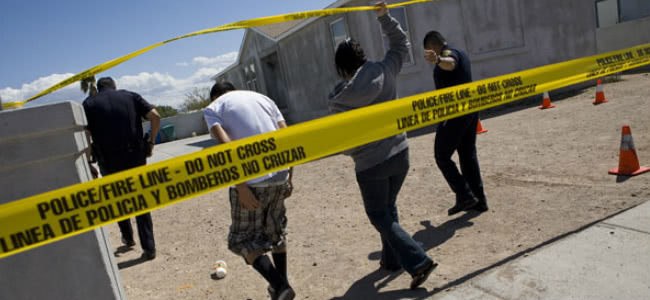While artists, fans, and industry commentators continue to debate the pros and cons of signing with a major label or remaining independent in the digital age, artists in Mexico have another route available to them, though it’s one that could cost them their lives.
“It’s like a horror movie,” says one Mexican promoter. “Artists get killed because they played at a party for a [rival] drug dealer; because they looked at a dealer’s girlfriend; because they get paid to write or record a song about one dealer and a rival gets upset; or because they somehow piss off the dealer who’s funding their career.”
They’re called narcocorridos, danceable, accordion-driven songs that tell celebratory narratives about the drug dealers that have Mexico in their grasp. The songs are becoming increasingly popular and the artists who perform them are paying the ultimate price for fame.
As Billboard reports, on 27th February, 20-year-old singer Alfredito Olivas was shot eight times while performing at a Parral nightclub. On 22nd March, grupero star Javier Rosas was shot multiple times while riding in an SUV in Sinaloa, home of the notorious Sinaloa Cartel.
Both singers survived. However, 22-year-old Rogelio Brambila Lizarraga, singer of Los Plebes del Arranke, a group whose songs made reference to the Arellano Felix Cartel, was not as lucky. His body was found in a parked cark in Tijuana on 21st March, riddled with bullets from two different guns.
These deaths, which, along with the death of singer Ariel Camacho in a car accident, took place within the span of four weeks, aren’t merely collateral damage in a country that’s become ravaged by drug violence – they’re simply par for the course for performers of the genre.
Rosas, who sang songs about the Sinaloa Cartel, and Lizarraga are rumoured to have been targeted by rival gangs, while Olivas was said to have been flirting with the girlfriend of the man arrested for his shooting.
“When a singer gets shot, it gets bigger headlines than a police chief getting shot,” Elijah Wald, author of Narcocorrido: A Journey into the Music of Drugs, Guns and Guerillas, tells Billboard. And there’s little fear of retribution, too.
“Impunity is very high: They kill because they can. And murder is news, which is what killers seek, and it’s particularly newsy if you’re dealing with a famous singer,” says Alfredo Corchado, Mexico City bureau chief for the Dallas Morning News and author of the book Midnight in Mexico.
If you’re wondering why young artists would take such a lethal risk, you may be surprised to learn that Mexico’s underworld figures are in fact the largest benefactors of many regional Mexican musicians’ careers.
“Think about it. You’re a young artist and someone offers you $100,000 to record a song and make it a hit. It goes to No. 1, and suddenly Univision and Telemundo are battling for you,” one anonymous Mexican promoter tells Billboard.
[include_post id=”352355″]
The killing spree dates back to the early ’90s with the death of Chalino Sanchez in 1992. Back then, the “narco” variation of Mexico’s traditional corridos’ were still underground, but they’ve grown in popularity with the country’s drug violence.
Since then, at least a dozen big-name acts have been murdered, including Valentin Elizalde in 2006 and Sergio Gomez in 2007. In 2013, 17 members of the band Kombo Kolombia were kidnapped and executed.
Following an investigation, the DA of Nuevo Leon said the performers’ deaths were ordered by their original benefactors, the Mexican cartel Los Zetas, considered by the US government to be the “most technologically advanced, sophisticated, and dangerous cartel operating in Mexico”. Their crime? Performing for rival cartels.
However, despite these tragic incidents, there is little sympathy for performers seeking fame by mythologising the cartels, who’ve become infamous for their ruthless and indiscriminate mass killings of police, journalists, and civilians.
“If you’re not involved with drug dealers, there’s no reason to be afraid,” says another promoter, echoing the words of several others. Still, for now it seems the rise of narcocorridos and the bloodshed inherent in their performance will continue.
“There’s an old saying in Sinaloa: ‘I’d rather live five years like a king rather than 50 years like an ox,'” says Corchado. “When I first began covering this 10 years ago, I’d hear that in Sinaloa. Now I hear it all over Mexico. That’s our sad reality.”




































